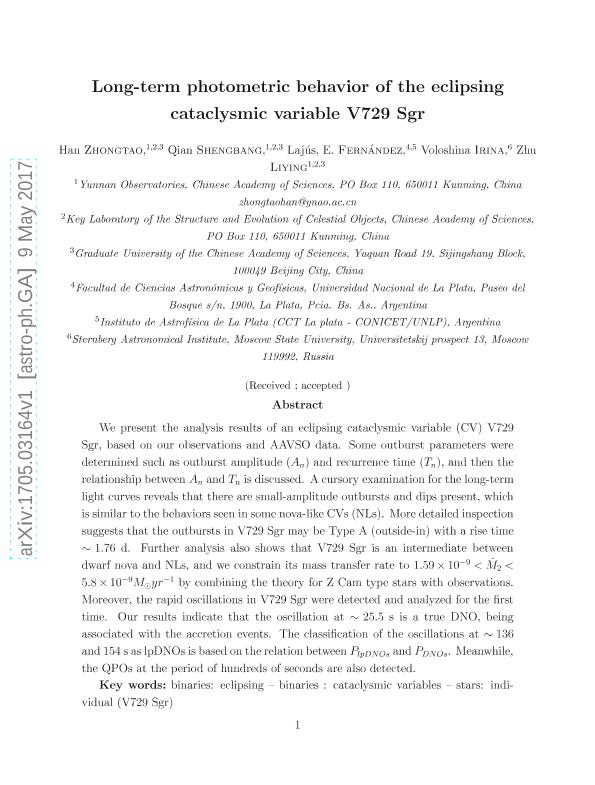Mostrar el registro sencillo del ítem
dc.contributor.author
Han, Zhong-Tao
dc.contributor.author
Qian, Sheng-Bang
dc.contributor.author
Fernandez Lajus, Eduardo Eusebio

dc.contributor.author
Voloshina, Irina
dc.contributor.author
Zhu, Li-Ying
dc.date.available
2018-05-11T14:50:20Z
dc.date.issued
2017-05
dc.identifier.citation
Han, Zhong-Tao; Qian, Sheng-Bang; Fernandez Lajus, Eduardo Eusebio; Voloshina, Irina; Zhu, Li-Ying; Long-term photometric behavior of the eclipsing cataclysmic variable V729 Sgr; Astronomical Soc Japan; Publications Of The Astronomical Society Of Japan; 69; 3; 5-2017; 55-64
dc.identifier.issn
0004-6264
dc.identifier.uri
http://hdl.handle.net/11336/44904
dc.description.abstract
We present the analysis results of an eclipsing cataclysmic variable (CV) V729 Sgr, based on our observations and American Association of Variable Star Observers data. Some outburst parameters are determined, such as outburst amplitude (An) and recurrence time (Tn), and then the relationship between An and Tn is discussed. A cursory examination of the long-term light curves reveals that there are small-amplitude outbursts and dips present, which is similar to the behavior seen in some novalike CVs (NLs). More detailed inspection suggests that the outbursts in V729 Sgr may be Type A (outside-in) with a rise time ∼1.76 d. Further analysis also shows that V729 Sgr is an intermediate between dwarf nova and NLs, and we constrain its mass transfer rate to 1.59×10−9<M˙2<5.8×10−9M⊙ 1.59×10−9<M˙2<5.8×10−9M⊙ yr−1 by combining the theory for Z Cam type stars with observations. Moreover, the rapid oscillations in V729 Sgr were detected and analyzed for the first time. Our results indicate that the oscillation at ∼25.5 s is a true dwarf nova oscillation (DNO), being associated with the accretion events. The classification of the oscillations at ∼136 and 154 s as longer-period DNOs (lpDNOs) is based on the relation between PlpDNOs and PDNOs. Meanwhile, quasi-periodic oscillations with periods of hundreds of seconds are also detected.
dc.format
application/pdf
dc.language.iso
eng
dc.publisher
Astronomical Soc Japan

dc.rights
info:eu-repo/semantics/openAccess
dc.rights.uri
https://creativecommons.org/licenses/by-nc-sa/2.5/ar/
dc.subject
Eclipsing Binaries
dc.subject
Cataclysms Variables
dc.subject
V729 Sagitarii (Estrella)
dc.subject.classification
Astronomía

dc.subject.classification
Ciencias Físicas

dc.subject.classification
CIENCIAS NATURALES Y EXACTAS

dc.title
Long-term photometric behavior of the eclipsing cataclysmic variable V729 Sgr
dc.type
info:eu-repo/semantics/article
dc.type
info:ar-repo/semantics/artículo
dc.type
info:eu-repo/semantics/publishedVersion
dc.date.updated
2018-04-23T15:38:06Z
dc.journal.volume
69
dc.journal.number
3
dc.journal.pagination
55-64
dc.journal.pais
Japón

dc.journal.ciudad
Tokio
dc.description.fil
Fil: Han, Zhong-Tao. Chinese Academy of Sciences; República de China
dc.description.fil
Fil: Qian, Sheng-Bang. Chinese Academy of Sciences; República de China
dc.description.fil
Fil: Fernandez Lajus, Eduardo Eusebio. Universidad Nacional de La Plata. Facultad de Ciencias Astronómicas y Geofísicas; Argentina. Consejo Nacional de Investigaciones Científicas y Técnicas. Centro Científico Tecnológico Conicet - La Plata. Instituto de Astrofísica La Plata. Universidad Nacional de La Plata. Facultad de Ciencias Astronómicas y Geofísicas. Instituto de Astrofísica La Plata; Argentina
dc.description.fil
Fil: Voloshina, Irina. Moscow State University; Rusia
dc.description.fil
Fil: Zhu, Li-Ying. Chinese Academy of Sciences; República de China
dc.journal.title
Publications Of The Astronomical Society Of Japan

dc.relation.alternativeid
info:eu-repo/semantics/altIdentifier/doi/http://dx.doi.org/10.1093/pasj/psx030
dc.relation.alternativeid
info:eu-repo/semantics/altIdentifier/url/https://academic.oup.com/pasj/article-abstract/69/3/55/3798176?redirectedFrom=fulltext
Archivos asociados
